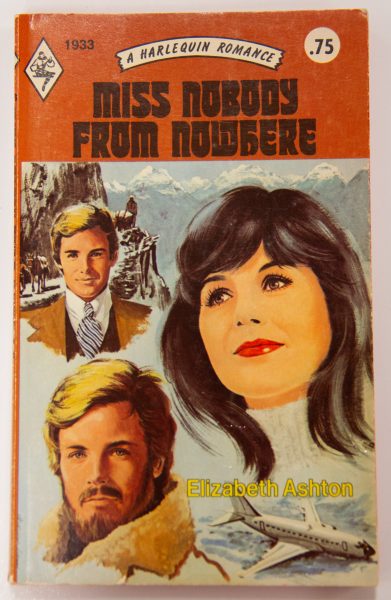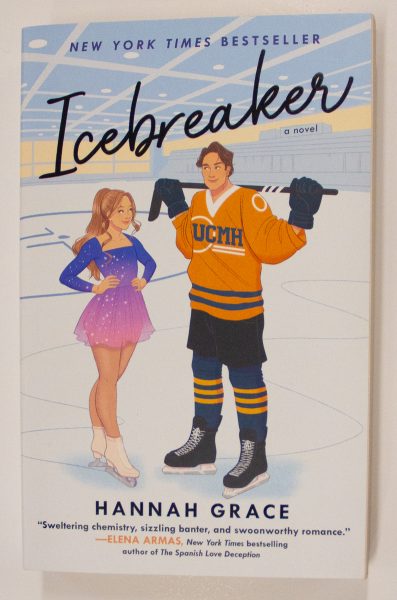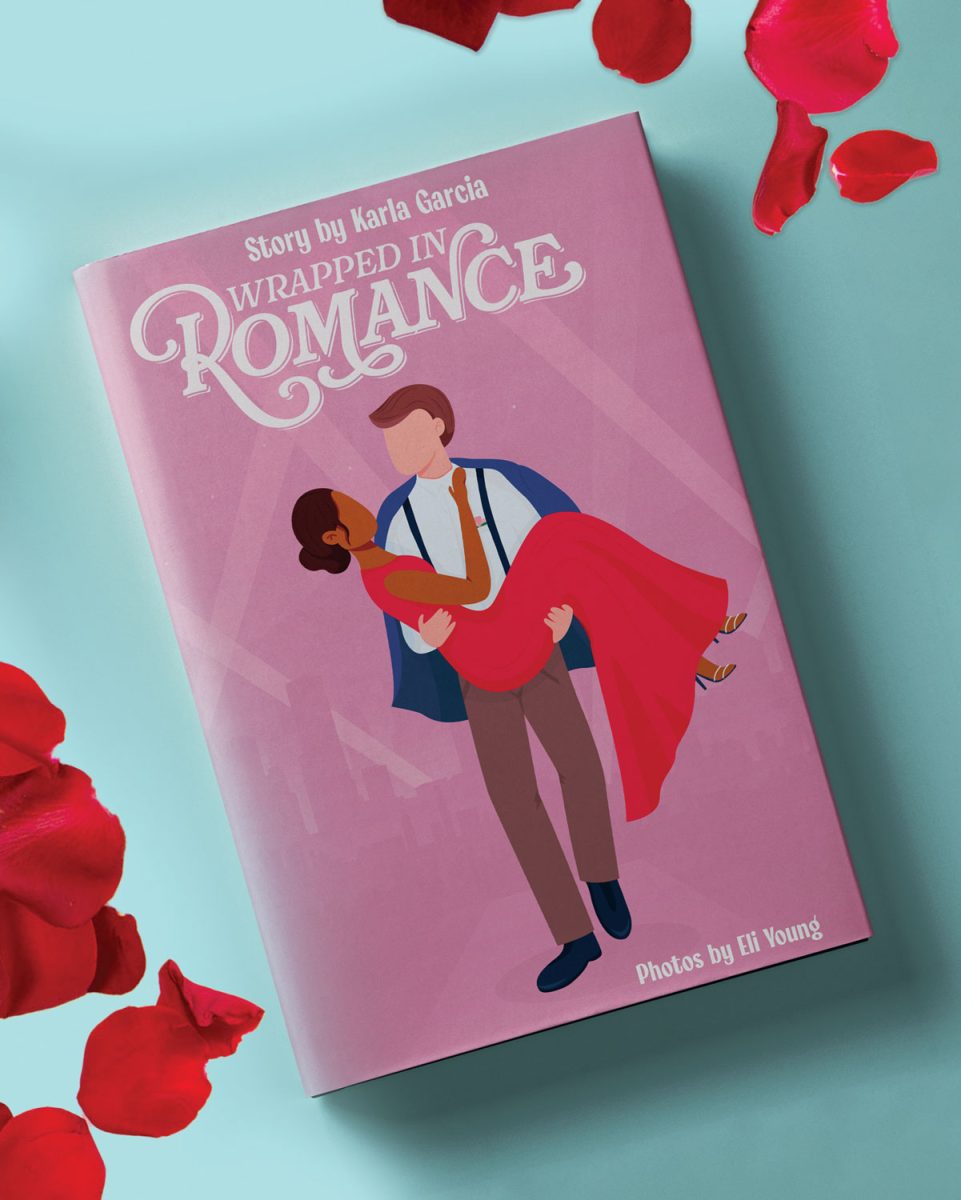As book lover Jullie Carranco enters through the large double doors of Barnes & Noble, she is greeted with the #BookTok display. From the selection of brightly colored books, Carranco picks up “Icebreaker” by Hannah Grace. The cover shows an illustration of a female figure skater and a male hockey player in an ice rink, smiling at one another. After reading the blurb on the back cover, she heads to the checkout line. However, after spending her afternoon reading “Icebreaker,” Carranco comes to the realization that next time she should think twice about judging a book by its cover.
Brightly colored romance book covers with illustrations of cartoon-like characters are everywhere today. Many readers praise this new wave of book covers because they can be discreet about the sexually explicit content within the books. On the other hand, many have raised the concern that these covers can be misleading. These covers are just the book industry’s latest approach to marketing to new audiences. The romance genre, as well as its cover art, is constantly evolving. Trends in romance book covers work to reflect the cultural zeitgeist—and women’s tastes. As a genre that has historically been by women for women, heroine’s storylines have also changed with the covers that wrap around their love stories.
Romance novels have always been a thriving industry, but as the 1970s approached, it introduced a big game changer to the genre: Harlequin Enterprises, one of the first publishing companies to directly market to women. Harlequin began selling mass market paperbacks where women typically already shopped—drug stores, grocery stores and department stores.
Jayashree Kamblé, professor of English at La Guardia Community College in New York City, explains how Harlequin used the same marketing techniques businesses used to sell soap in order to sell more books. Lawrence Heisey, the president of Harlequin in the ‘70s, brought his business experience to the company and was responsible for revolutionizing the romance book publishing industry with this clever marketing strategy.
“That’s why people will pick it, like the cues of color, the cues of the shape, the cues of the font, the cues of like whether they’re putting glitter on it or embossing on the brand and all that stuff. So, Harlequin sort of creates a particular look,” says Kamblé.
These Harlequin romance novels did not include detailed sexually explicit content, reflecting the chaste social ideals of the early 1970s. Couples on these covers rarely displayed physical affection with one another and instead looked out to the reader—a direct marketing tactic to entice potential readers. Harlequin covers also often featured the “floating heads” style of cover art, where characters were only seen from their shoulders up with scenery in the background. This style of cover art was usually collages of images put together or paintings.

The 1970s were also a time of radical social and political reform. The women’s liberation movement and sexual revolution of the mid to late 1970s completely shifted society’s perception of women’s equality and challenged socially accepted norms about sexuality and relationships. This cultural shift brought massive changes to the romance book industry, especially with its covers. By the 1980s, the term “clinch cover” was coined to describe the more provocative and risqué romance book covers that took this era by storm. Clinch covers always featured a man and a woman in a passionate embrace with expressions of ecstasy on their faces. Men were typically shirtless, and women wore loose fitting dresses to give the impression that their clothes were about to fall off. These illustrations were a clear indicator of the increased presence of sexually explicit content in the novel.
A major artist during this era was Elaine Duillo, who painted the most iconic and well-known romance book covers: the Fabio covers. Fabio Lanzoni was a male model who appeared on the covers of over 466 romance novels throughout the span of the 1980s and 1990s. Readers in this era were especially captivated by his long blond hair, muscular physique, and defined jaw—the perfect picture of masculinity and sex appeal.
As new technologies began to advance in the 21st century, many book covers began to move away from paintings, which had been the standard for decades. Throughout the 2000s and all through the mid 2010s, photographs of models on romance book covers became the norm. Many of these covers featured conventionally attractive models either posed together or individually.

However, these photorealistic covers weren’t—and still aren’t—widely loved by everyone. Jane Nutter is the senior communications and marketing manager at Kensington Books in New York City, which specializes in a range of fiction and non-fiction titles such as romance, thrillers, sci-fi and true crime. She says that photo covers can detract from the intimate relationship readers create with the characters in the book.
“I hear this from a lot of readers that they don’t necessarily like to see the characters’ faces because they want to have their own image of what the characters look like,” says Nutter. “It’s hard not to make the association when you’re reading in your mind.”
A trend that was also popularized during the mid-2010s was book covers with solely the model’s torso in frame. The model’s nose down to their waist was the only area of their body that was visible on the cover. The most popular example of this type of cover are those with a man’s abs. The large text of the title name was usually displayed over these photos. This style of romance book covers especially captivated online literary communities, particularly on the app Wattpad.
Wattpad is an online reading app where users can publish their own stories as well as read others, most commonly fanfiction stories. Fanfiction is a popular genre of fiction, typically posted online, written by fans of a book, movie or TV series. These stories incorporate existing characters from specific pieces of media into new storylines. Cover art with the model’s torso solely in frame was popularized on Wattpad because it was simple for users to find stock images of a conventionally attractive model and put large text over it.

Scanning the aisles of the romance section in Barnes and Noble today, one would find a completely different selection than the former clinch covers and photorealistic covers that dominated the romance genre just a few years ago. Books displayed on these shelves by romance authors such as Emily Henry, Ali Hazelwood and Tessa Bailey all have something in common—highly simplified, illustrated covers. With almost cartoon-like character designs, bright colors, and bold text, today’s romance covers are much less obvious than the sort of content that lies within a book’s pages. Romance novels with these sorts of covers are often found through #BookTok, the literary community on TikTok.
In 2020, #BookTok began as a niche subcommunity on TikTok where users would recommend and review books, mostly fantasy and romance. #BookTok is now an official hashtag on TikTok with over 30 million posts. As the #BookTok community has become more mainstream, so have their book recommendations. Various bookstores even have displays dedicated to these books. The rise of #BookTok has also led to the renaissance of romance novels in a way that hasn’t been seen before. The term “#BookTok book” has almost become synonymous with these illustrated, cartoon-like covers. The illustrated covers have attracted a new demographic of millennial and Gen Z readers who wouldn’t have typically picked up a romance novel before.

“It absolutely was intentional in terms of cover direction,” says Nutter. “People would pick them up, look at them, and then be like, ‘oh, this looks nice,’ and get it and not really be one of the, like, diehard romance readers.”
Romance is typically a genre made by women for women and due to patriarchal values, it has been looked down on for its combination of emotional, sentimental and sexual content. Kamblé explains how many readers worry this negative bias will also apply to them if they read romance.
“You go from the Fabio cover, which people are like, oh my God, if I read that people will think I’m this, that and the other, like, negative assumptions,” says Kamblé. She says these illustrated covers help to reduce the negative stigma and bias around reading romance novels. “It’s a cover that’s got some cute people on it. It may still not be, you know, high literature… but maybe, at least people will not think that I’m just reading quote, unquote, erotica.”
This new era of romance book covers has also brought changes to the sort of content within them. Many modern romance novels have embraced a romantic comedy approach to stories. These brightly colored, illustrated covers can sometimes be an indicator of the lighthearted and humorous content within the novel.

“The cartoon cover kind of plays into that playful humor,” Nutter says. “The cutesy looking covers, they look warm, they look friendly. These books look fun.”
The modern romance novels are also more character-driven and focus more on the heroine’s arc as complex characters. “The women are a lot more front and center. People are now gravitating to the female gaze of it, as like I’m looking at examples of other women going through something that I might be going through,” Nutter says.
However, not everyone is a fan of this new take on romance book covers. Many have voiced the sentiment that these illustrated book covers can be misleading and can cause young readers to unknowingly purchase books that contain sexually explicit content. “Icebreaker,” the book Carranco purchased, has particularly received a lot of backlash online.
One Amazon reviewer writes, “My [fifth] grader had it on her reading wish list. I saw the cute front cover and high rating and thought nothing of it. My child took it into school and I got the awkward teacher phone call telling me the book was filled with sex and bad words.”
There’s debate over whether it’s the responsibility of the publisher, the author, or bookstore to clarify the sort of contents in romance books. Regardless, lovers of romance novels are still finding their way to these books. And experts say there is more to these novels than just the smoldering love scenes.
“I think romance is one of the first genres that really starts to reflect what we as a society want to believe in terms of relationships,” Nutter says. “The genre is much more in tune to what’s going on in our society in general than some other genres.”
Jullie Carranco also personally wasn’t a fan of the excessive sexually explicit content when reading “Icebreaker.” Carranco says, “There was so much that it kind of took away from the story for me, that at one point, it does become a little bit embarrassing. Because it’s like, I also still want story.” While she may have had a bad experience with “Icebreaker,” Carranco says this doesn’t turn her away from romance, her favorite book genre. “Romance is such a relevant topic today. Like, it’s popular for a reason, you know? You can’t deny that. I think just because something is popular doesn’t mean that it’s always bad or not able to convey some form of intelligent message.”
Taken from the Summer 2024 issue of Inside Fullerton. Read it here.




